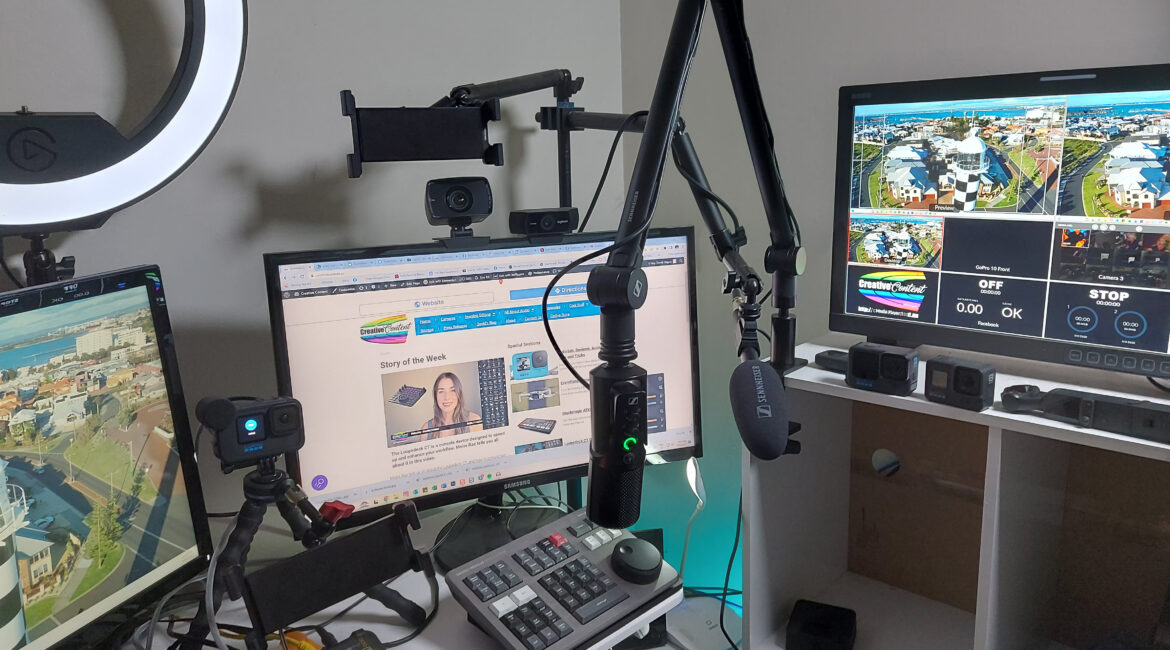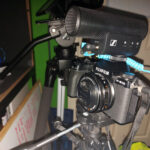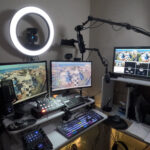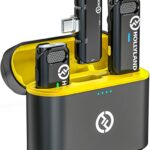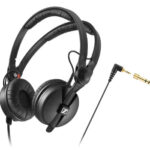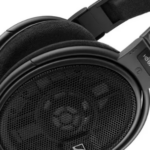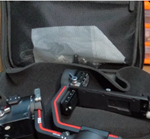I am very fond of Sennheiser mics. Over the years, I have had the opportunity to try just about every mic on the market (designed for the stuff I do anyway), and with very few exceptions, I have graduated to a Sennheiser model.
(Those exceptions if you are interested are for the DJI Mic or Hollyland Lark M1 for an inexpensive wireless lav and the RØDE VideoMicro II for a lightweight on-the-road top of camera unit).
Recently, as I have decided to start podcasting, it became necessary to see what mics were available to me in this area. I already had an Elgato Wave:3 and a Presonus Revelator, so I set these up on booms and plugged them in.
The days of using 3.5mm or “headphone jacks” are long gone at this level of mic; everything these days is USB-C and this can actually cause a bit of an issue. My desktop, a Dell XPS is only a few months old and yet still has only a single dedicated USB-C port, meaning that, unless adaptors are used, which I am loathe to implement, you are forever unplugging and re-plugging devices. Thankfully it is on the front of the unit, but nonetheless, as the box is on the floor under the desk, there is some ground level grovelling needed. My last Dell had the one and only USB-C port on the rear, and THAT was a bloody nightmare!
Anyway, between the two mics, I managed to get some samples going for comparison purposes. Now both of these models have semi-smarts built in, accessed by dials on the front of the mic and / or via driver software, so testing was not as simple as just plugging in and doing the standard “icicles, popsicles, test…. ing 1-2-3” malarkey.
After a fair bit of faffing about using Audition, Sound Forge and Audacity I had enough samples to decide I liked the Presonus Revelator over the Elgato. In the ambience of my small studio, it gave a clearer speaking voice image and was easier to operate.
Not directly related, but I also preferred their boom stand makeup.
And then a spanner in the works arrived in the form of an email from my contact at Sennheiser saying that had just released a new mic called the Profile, designed specifically for blogging.
How could I refuse?
A few days later, my friendly local Startrack driver ding donged the door bell, and in a nice Sennheiser Blue box given to me was a Sennheiser Profile mic with a boom arm and mount.
Description
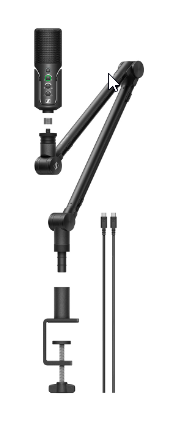 Like the Elgato and Presonus, the SennheiserProfile mic is built from steel and designed to sit vertically, has front and rear mounted controls. On the front are the gain, mute, headphone / mic mix and headphone volume controls, and on the rear the USB-C and headphone jack port.
Like the Elgato and Presonus, the SennheiserProfile mic is built from steel and designed to sit vertically, has front and rear mounted controls. On the front are the gain, mute, headphone / mic mix and headphone volume controls, and on the rear the USB-C and headphone jack port.
LED rings on the Profile conveniently signal the operating status; when the LED ring around the gain control is green, the mic is ready to go and when the same light ring turns yellow at times or all of the time, the mic is clipping and you need to reduce the mic volume. When the microphone has been muted, rings around the mute button and the gain control light up red.
A 2 metre USB-C to USB-C cable is supplied but oddly, no wind / foam sock. I am guessing the Sennheiser engineers figured if you are vlogging or podcasting, then indoors is where you’ll mostly be so no need.
Setting up the mic was as simple as mounting the boom arm base, slotting on the arm so it is free to rotate, screw in the mic, adjusting a second thread allowing the controls to be exactly where you want them, and then plugging the cable in.
Windows 11 detected the unit immediately and gave it priority.
The quality of sound without a single tweak was excellent. Below are the various wave files from Audacity from each of the 3 mics to give an indication with the top track being the Sennheiser, the middle the Elgato and the bottom the Presonus.
My original radio mentor, Mitch from Triple M in Sydney once told me I had “a great head for radio and an even better voice for writing”. (Nevertheless I did do a year’s on-air work with this station, a further 3 or so years with 2GB Talkback and a couple more with 88.7FM with my own show).
But I have to say, with Mitch’s words still ringing in my ears, the Sennheiser makes even me sound better than passable! The other two are certainly a pass mark, but do not (I think) give the crispness or brightness of the Sennheiser, and both also added a very slight but noticeable reverb to the audio.
Price Comparison
In the configuration I received, that is with the boom arm – which Sennheiser calls the Profile Streaming Set – as against the table stand, the Sennheiser Profile has a recommended retail price of AUD$349. If you instead opt for just the desktop stand with the mic, expect to pay around AUD$239.
By comparison, the Elgato Wave 3 with a desktop stand is AUD$269 (the boom is an optional extra for between AUD$149 and AUD$159 depending on the type. The Presonus Revelator is AUD$229 with the boom an extra AUD$169.
On this basis, the Sennheiser therefore is also excellent value. Match it with the Sennheiser Pro HD300 headphones (AUD$369) and in my opinion, you have a killer setup for making podcasts.
Technical Specifications
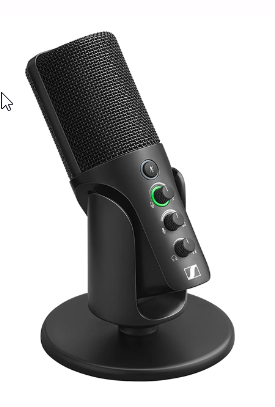 Microphone type: pre-polarised condenser microphone
Microphone type: pre-polarised condenser microphone
Pick-up pattern: cardioid
Powering: via USB-C (MacOS/iPadOS/Windows/Android)
Power supply: 5 V, max. 200 mA
OS interoperability: Windows 10.0 or higher; macOS 10.15 or higher; Android 9.0 or higher, iPad OS 14 or higher (compatible with USB-C enabled Apple devices)
Cable length: Profile: 1.2 m, Profile Streaming Set: 3 m
Frequency range: 20 to 20,000 Hz
Sampling rates: 44.1 kHz, 48 kHz
Sampling resolution: 16 Bit, 24 Bit
Max SPL: 125 dB SPL at min. gain, 85 dB SPL at max. gain
Sensitivity at max. gain: -10 dBFS at 80 dB SPL
Sensitivity at min. gain: -50 dBFS at 80 dB SPL
Connectors: USB type-C (USB 2.0 Full Speed); 3.5 mm TRS for headphone monitoring
Headphone output: frequency range 20 – 18,500 Hz, 16 ohms min. output impedance
More information can be obtained from https://en-au.sennheiser.com/profile-streaming-set
(The other mic you see in the picture is a Sennheiser MKE600 which is connected to the Blackmagic ATEM Mini Pro for live broadcast streaming. The controls and output for thr ATEM can be seen on the monitor on the right hand side. The camera (s) used for this are GoPro Hero 10 and 11′s inside MediaMods in order to get an HDMI signal into the ATEM. The Media Mod also allow me to supply power to the cameras negating on the need for batteries).’


